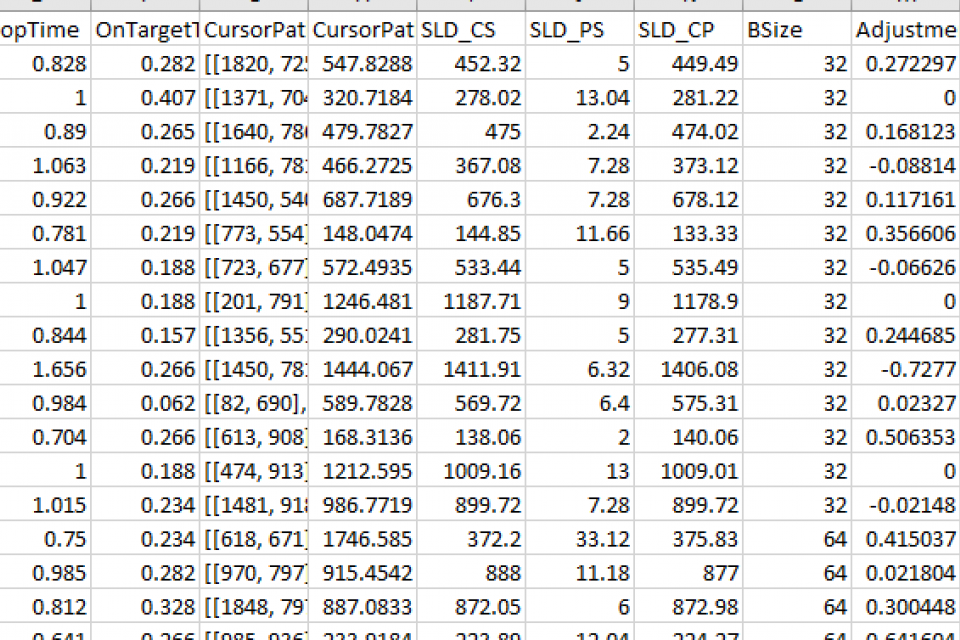Datasets
Standard Dataset

ANTASID: Cleaned Dataset of Uncontrolled Pointing Task Experiment
- Citation Author(s):
- Submitted by:
- Ridwan Kabir
- Last updated:
- Sat, 02/12/2022 - 22:39
- DOI:
- 10.21227/0p2q-md42
- Data Format:
- License:
 67 Views
67 Views- Categories:
- Keywords:
Abstract
Shannon’s Index of Difficulty (ID), reputable for quantifying the perceived difficulty of pointing tasks as a logarithmic relationship between movement-amplitude (A) and target-width (W), is used for modelling the corresponding observed movement-times (MT_O) in such tasks in controlled experimental setup. However, real-life pointing tasks are both spatially and temporally uncontrolled, being influenced by factors, such as – human aspects, subjective behavior, the context of interaction, the inherent speed-accuracy trade-off, where, emphasizing accuracy compromises speed of interaction and vice versa. Effective target-width (W_e) is considered as spatial adjustment for compensating accuracy. However, no significant adjustment exists in the literature for compensating speed in different contexts of interaction in these tasks. As a result, without any temporal adjustment, the true difficulty of an uncontrolled pointing task may be inaccurately quantified using Shannon’s ID. To verify this, we propose ANTASID (A Novel Temporal Adjustment to Shannon’s ID) formulation with detailed performance analysis. We hypothesized a temporal adjustment factor (t) as a binary logarithm of MT_O, compensating for speed due to contextual differences and minimizing the non-linearity between movement-amplitude and target-width. Considering spatial and/or temporal adjustments to ID, we conducted regression analysis using our own and Benchmark datasets in both controlled and uncontrolled scenarios of pointing tasks with a generic mouse. ANTASID formulation showed significantly superior fitness values and throughput in all the scenarios while reducing the standard error. Furthermore, the quantification of ID with ANTASID varied significantly compared to the classical formulations of Shannon’s ID, validating the purpose of this study.
The Dataset features trial data from the Uncontrolled interactions of the participants with the game “Popper” (developed in-house using Python). There are a total of 6469 trial data with 4291 (66.33%) from homogeneous and 2178 (33.67%) from heterogeneous trials in the file “ANTASID-Cleaned Dataset of Uncontrolled Pointing Task Experiment.csv”. The parameters stored in this file and their interpretations are mentioned as follows -
- Index: Defines the Level Type, Static (Homogeneous) or Static-Random (Heterogeneous).
- CursorAt: Screen coordinate of cursor at the time of target appearance.
- SpawnAt: Screen coordinate of target at the time of appearance.
- PopAt:Screen coordinate of target at the time of popping.
- PopTime: Time taken to pop a target.
- OnTargetTime: Time spent on a target.
- CursorPath: List of screen coordinates in cursor trajectory.
- CursorPathLength: Length of the cursor trajectory.
- SLD_CS: Straight Line Distance between the screen coordinates of the Target-center and the Cursor at the time of target Appearance.
- SLD_PS: Straight Line Distance between the screen coordinates of the Target-center and the Cursor at the time of target Popping.
- SLD_CP: Straight Line Distance between the screen coordinates of the Cursor at the time of target Appearance and at the time of target Popping.
- BSize: Target Size in pixels (32 px, 64 px, 96 px, 128 px).
- AdjustmentFactor: Temporal Adjustment Factor.
- ID_NA: Unadjusted Shannon's Index of Difficulty (ID).
- ID_TA: Temporally adjusted Shannon's Index of Difficulty (ID).
- ID_SA: Spatially adjusted Shannon's Index of Difficulty (ID).
- ID_TSA: Temporally and Spatially adjusted, Shannon's Index of Difficulty (ID).






